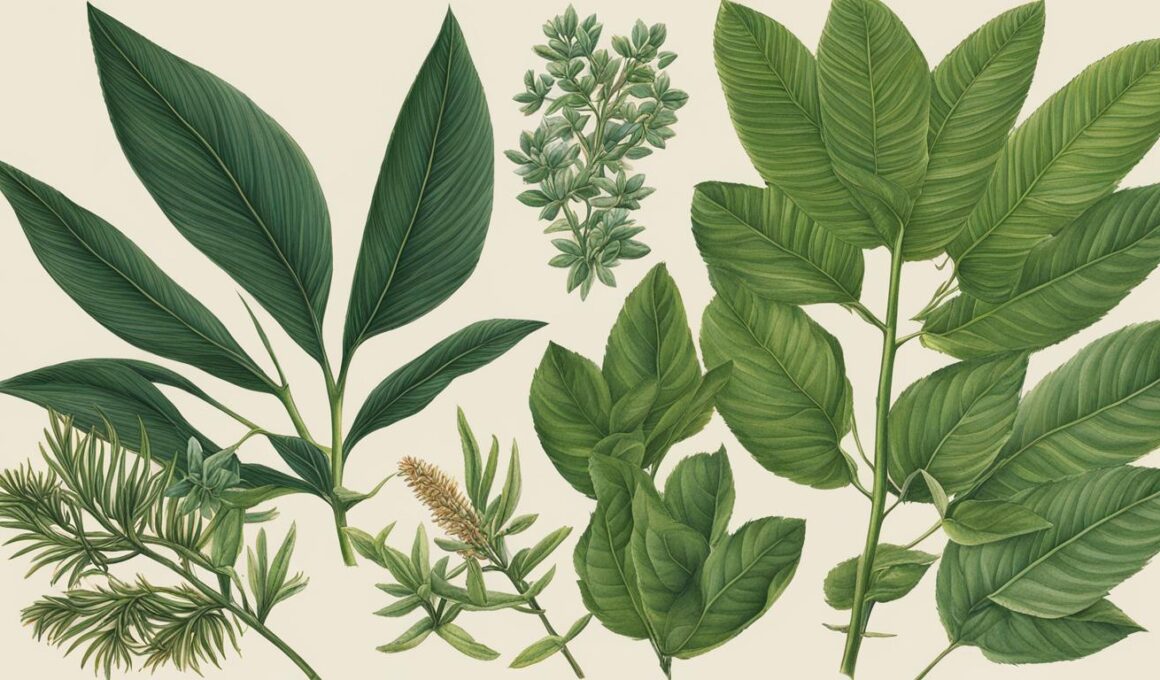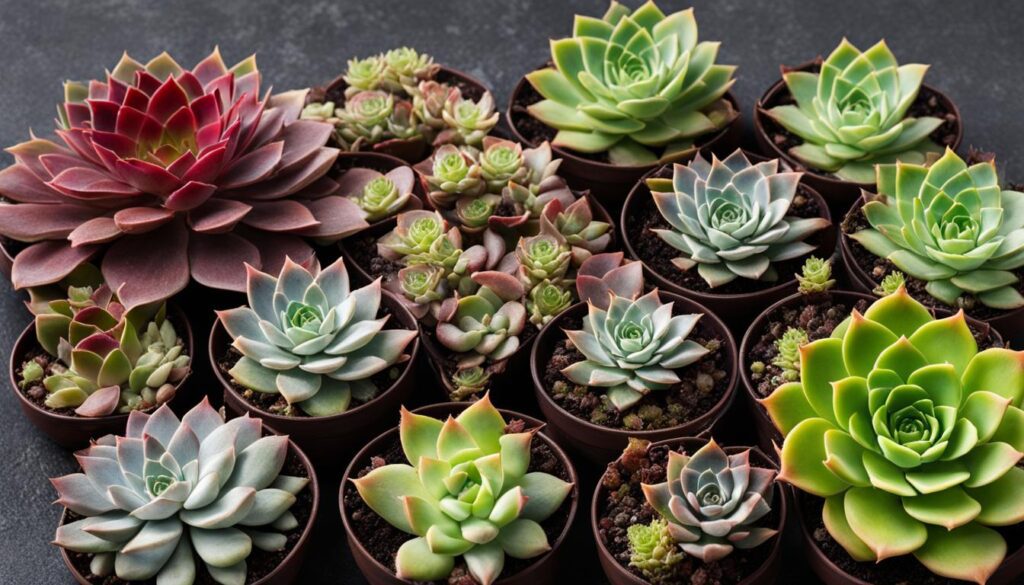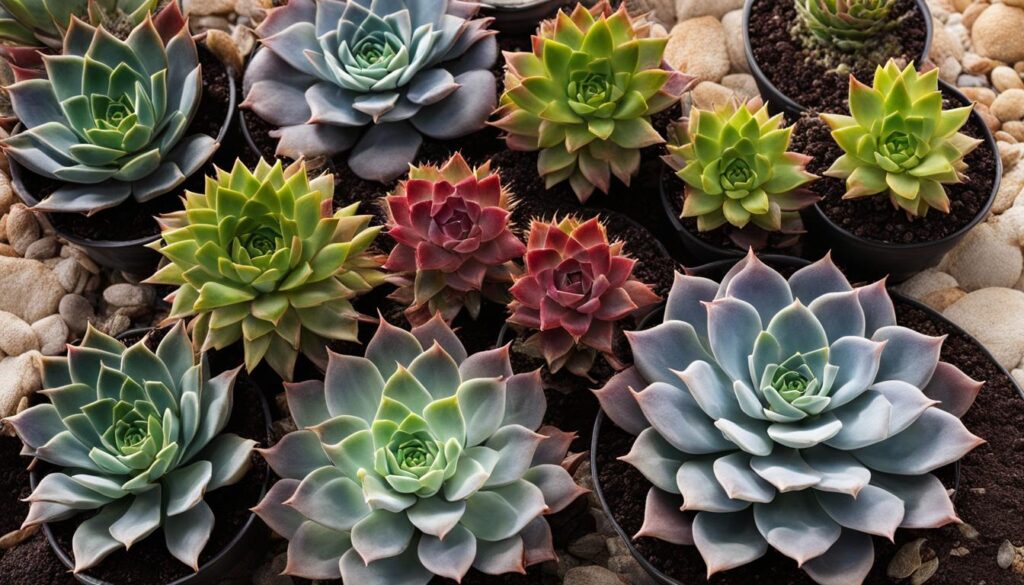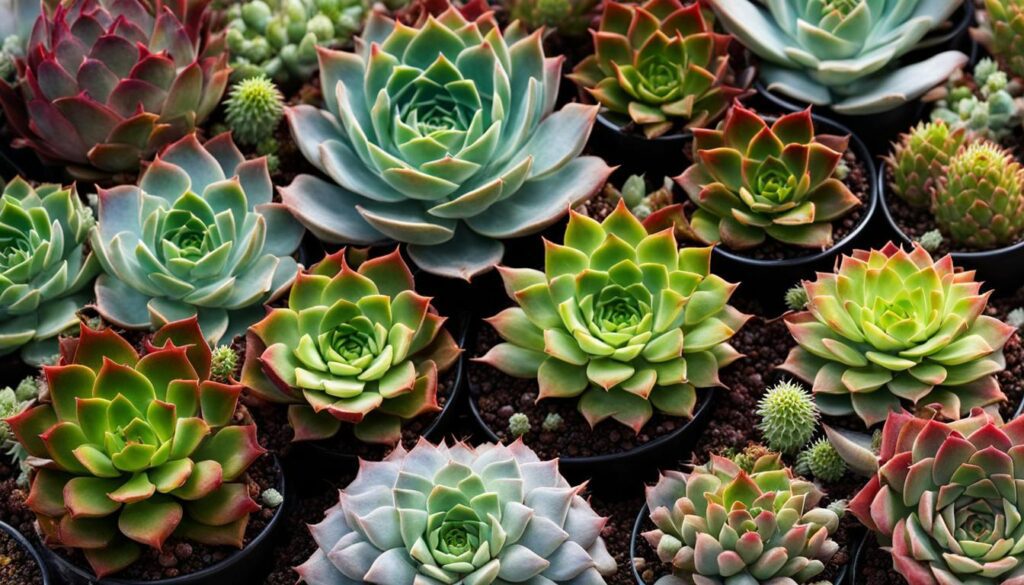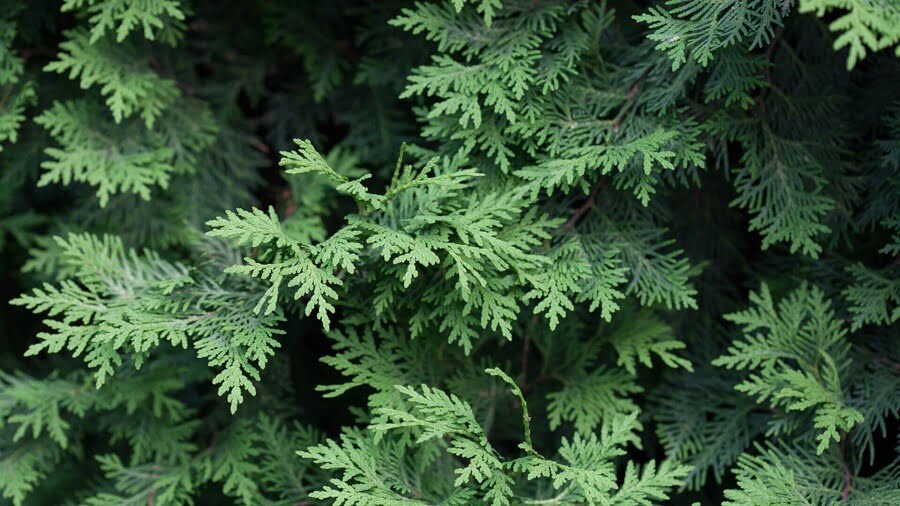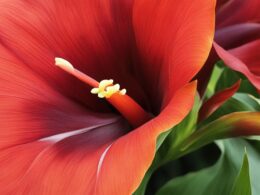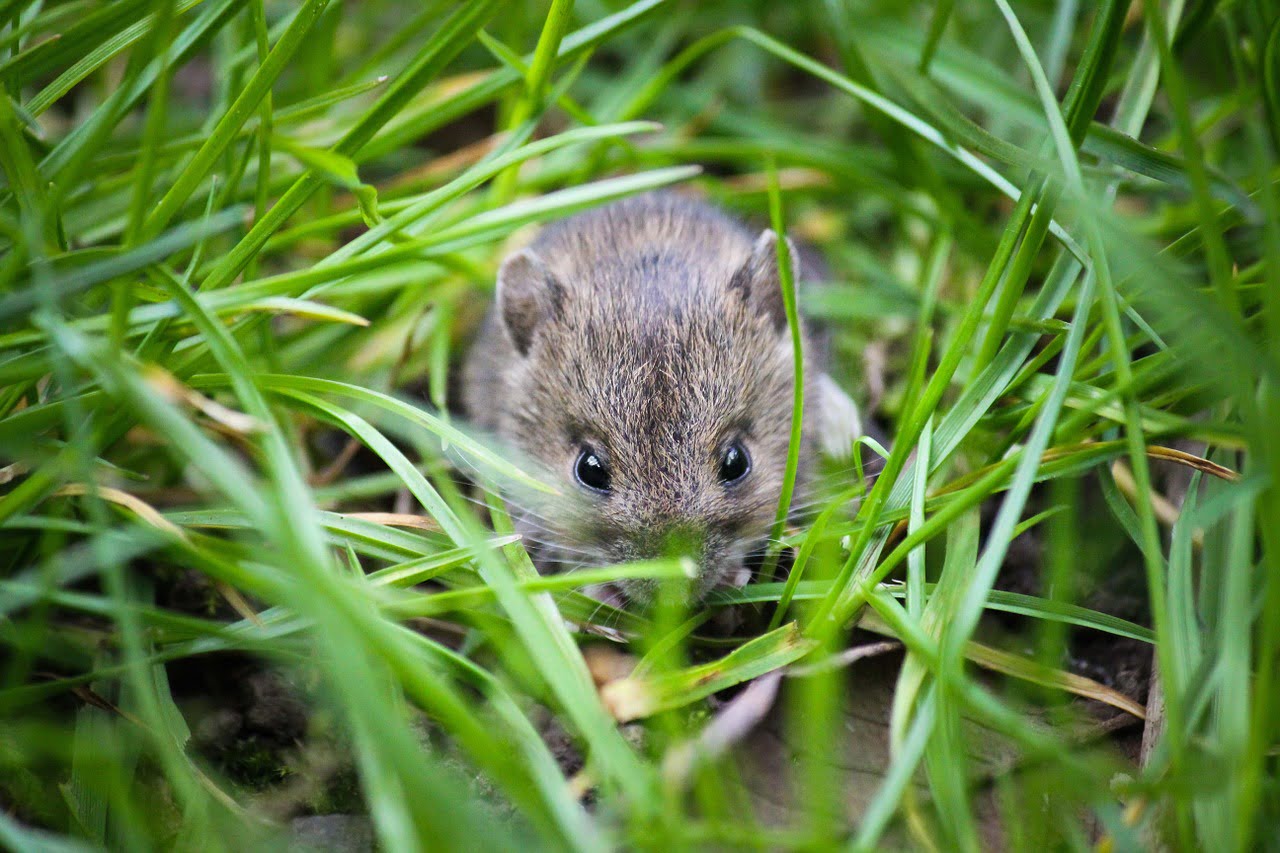Sempervivum and Echeveria may look similar, but there are important differences between the two. Understanding these differences can help you choose the right succulent for your needs.
Key Takeaways
- Sempervivum and Echeveria have distinct differences in appearance and care needs.
- Sempervivum is hardy and prefers cold weather, while Echeveria is tender and does not tolerate cold temperatures well.
- The edges of Sempervivum leaves are toothed, while the edges of Echeveria leaves are smooth.
- Sempervivum is monocarpic, flowering once in its lifetime, while Echeveria can flower annually.
- Both succulents require well-draining soil and infrequent but deep watering.
Appearance of Sempervivum and Echeveria
When it comes to appearance, Sempervivum and Echeveria exhibit distinct differences in their leaves, coloration, and flowers. Sempervivum, also known as Hens and Chicks, features narrow, pointy leaves with toothed edges. These leaves can display a range of colors, particularly during the fall when they showcase vibrant shades of red, orange, and purple. On the other hand, Echeveria boasts rosette-shaped leaves with smooth edges. The leaves of Echeveria can vary in color from green to purple, blue, pink, and even black, adding a visually striking element to any garden or indoor space.
Not only do the leaves of Sempervivum and Echeveria differ, but their flowers also showcase distinct characteristics. Sempervivum produces star-shaped flowers that emerge on tall stalks. These flowers add a delicate and beautiful touch to the plant. In contrast, Echeveria displays bell-shaped blooms that sit atop long, slender stems. The flowers of Echeveria come in various colors, depending on the species and cultivar, enhancing the overall aesthetic appeal of the plant.
| Sempervivum | Echeveria | |
|---|---|---|
| Leaf Shape | Narrow, pointy | Rosette-shaped |
| Leaf Edges | Toothed | Smooth |
| Leaf Color | Various colors, especially vibrant in fall | Green, purple, blue, pink, black |
| Flower Shape | Star-shaped | Bell-shaped |
| Flower Stalks | Tall | Long, slender |
The visual differences between Sempervivum and Echeveria make them unique in their own right. Whether you prefer the striking colors and toothed leaves of Sempervivum or the rosette shape and smooth leaves of Echeveria, both succulents offer a visually captivating addition to any plant collection.
Native Habitat and Preferred Climate
Sempervivum and Echeveria have different native habitats and preferred climates. Sempervivum is native to Europe, while Echeveria is native to Central and South America. This difference in origin influences their climate preferences and overall hardiness.
Sempervivum is well-suited to cooler, mountainous regions. It thrives in these environments and is able to withstand cold temperatures with ease. In fact, Sempervivum is known for its cold-hardiness, withstanding temperatures as low as -20°F. This makes it a great choice for gardeners in colder climates or those looking for a resilient plant that can withstand harsh winters.
Echeveria, on the other hand, is better adapted to hot, arid climates. It prefers warm temperatures and does not tolerate frost well. Echeveria thrives in regions with consistent heat, such as the deserts of Central and South America. If you live in a warmer climate or have a greenhouse or indoor space where temperatures can be controlled, Echeveria is an excellent choice.
Understanding the native habitats and preferred climates of Sempervivum and Echeveria is essential for successfully growing and caring for these plants. By providing them with the right climate conditions, you can ensure their optimal growth and health.
Watering and Care Requirements
Proper watering and care are essential for the health and vitality of both Sempervivum and Echeveria. These succulents have specific needs when it comes to watering and the type of soil they prefer.
Watering
Both Sempervivum and Echeveria thrive in well-draining soil and prefer infrequent watering. Overwatering can lead to root rot and other issues, so it’s important to allow the soil to dry out between waterings. To ensure proper watering, follow these guidelines:
- Water deeply: When it’s time to water your succulents, soak the soil thoroughly until excess water drains out from the bottom of the pot or container.
- Allow drying: Allow the soil to completely dry out before watering again. This can take anywhere from one to two weeks, depending on factors such as temperature, humidity, and the type of potting mix you use.
- Observe the leaves: Pay attention to the leaves of your plants. If they start to look plump and swollen, it’s a sign that they have enough water. If the leaves appear shriveled or wrinkled, it’s time to water.
Care Requirements
In addition to proper watering, Sempervivum and Echeveria have specific care requirements that will help them thrive:
- Light: Both succulents prefer bright, indirect light. Place them in a location where they can receive at least six hours of sunlight per day.
- Temperature: Sempervivum can tolerate cold temperatures and is hardy in USDA zones 3 to 11. Echeveria, on the other hand, is more sensitive to cold and is suitable for USDA zones 9 to 11.
- Soil: Use a well-draining potting mix specifically formulated for succulents. This type of soil will prevent water from pooling around the roots and causing root rot.
- Fertilizer: During the growing season, which is typically spring and summer, you can fertilize your succulents once a month with a balanced fertilizer. Avoid overfertilizing, as this can lead to leggy growth and other issues.
- Pruning: Remove any dead or damaged leaves from your succulents to promote healthy growth. You can also pinch back the tips of Echeveria to encourage branching.
By providing the right amount of water, light, and care, you can ensure that your Sempervivum and Echeveria thrive and bring beauty to your indoor or outdoor space.
| Sempervivum | Echeveria | |
|---|---|---|
| Watering | Infrequent but deep watering | Infrequent but deep watering |
| Soil | Well-draining soil | Well-draining soil |
| Light | Bright, indirect light | Bright, indirect light |
| Temperature | Cold-tolerant, hardy in USDA zones 3 to 11 | Not frost-tolerant, suitable for USDA zones 9 to 11 |
| Fertilizer | Monthly application of balanced fertilizer during the growing season | Monthly application of balanced fertilizer during the growing season |
Propagation Methods
Both Sempervivum and Echeveria can be propagated through various methods, allowing you to expand your succulent collection or share plants with friends and family. Here are the different propagation methods for each genus:
Propagation for Sempervivum:
1. Stem Cuttings: Take stem cuttings from mature Sempervivum plants. Allow the cuttings to callus for a few days, then place them in well-draining soil. Keep the soil lightly moist until roots develop.
2. Leaf Cuttings: Gently remove healthy leaves from Sempervivum rosettes. Let the cut ends dry and callus for a day or two. Plant the leaf cuttings in well-draining soil and mist lightly to keep the soil moist until new plants form.
3. Division: Sempervivum produces offsets, also known as “chicks,” around the base of the main rosette. Carefully separate the offsets from the mother plant using a sharp knife or your hands. Replant the offsets in their own containers or in a well-prepared garden bed.
Propagation for Echeveria:
1. Stem Cuttings: Take stem cuttings from healthy Echeveria plants, making sure the cuttings have several leaves. Allow the cut ends to callus for a few days, then plant them in well-draining soil. Water lightly and provide bright, indirect light until roots establish.
2. Leaf Cuttings: Gently remove healthy leaves from Echeveria rosettes, taking care not to damage the leaf base. Let the cut ends dry and callus for a day or two. Plant the leaf cuttings in well-draining soil and mist lightly to keep the soil slightly moist. New plants will form from the base of the leaf.
3. Division: Echeveria can also be propagated through division. Carefully separate a healthy rosette from the mother plant, ensuring it has roots attached. Plant the rosette in well-draining soil and provide appropriate care for root development and growth.
Propagation allows you to multiply your Sempervivum and Echeveria plants, creating a stunning succulent display or sharing the beauty of these plants with others. With the right techniques and care, you can enjoy an ever-growing collection of these unique and fascinating succulents.
| Propagation Method | Sempervivum | Echeveria |
|---|---|---|
| Stem Cuttings | Yes | Yes |
| Leaf Cuttings | Yes | Yes |
| Division | Yes | Yes |
Cold Hardiness and USDA Zones
Understanding the cold hardiness and USDA zones for Sempervivum and Echeveria is crucial for successful cultivation. While Echeveria is not frost-tolerant and thrives in warm climates, Sempervivum is remarkably cold-hardy and can withstand temperatures as low as -20°F (-29°C). This difference in cold tolerance means that Echeveria is most suitable for USDA hardiness zones 9 to 11, which experience milder winters, while Sempervivum can be grown in USDA zones 3 to 11.
In colder zones, Sempervivum’s ability to withstand freezing temperatures makes it an excellent choice for gardeners seeking resilient succulents that can endure harsh winter conditions. On the other hand, Echeveria’s preference for warmer climates means it is best suited for regions with mild winters or as indoor plants.
To determine the specific USDA zone of your region, consult the USDA Plant Hardiness Zone Map, which divides North America into various climatic zones based on average annual minimum temperatures. This information will guide you in selecting the most suitable succulents for your garden or indoor space, ensuring optimal growth and survival.
Cold Hardiness and USDA Zones for Sempervivum and Echeveria
| Cold Hardiness | USDA Zones | |
|---|---|---|
| Sempervivum | Cold-hardy, tolerant of temperatures down to -20°F (-29°C) | Zones 3 to 11 |
| Echeveria | Not frost-tolerant, prefers warmer climates | Zones 9 to 11 |
Common Pests and Diseases
Sempervivum and Echeveria, like any other plants, are susceptible to certain pests and diseases that can affect their health and appearance. It is important to be aware of these common issues and take appropriate measures to prevent and manage them.
Pests
Two common pests that can infest Sempervivum and Echeveria are mealybugs and spider mites. Mealybugs are small, white, cottony insects that feed on plant sap, while spider mites are tiny pests that can cause webbing and suck sap from the leaves. Both pests can cause damage to the plants by weakening them and causing discoloration.
To prevent and manage pest infestations, regularly inspect your succulents for any signs of pests, such as visible insects, white cottony masses, or webbing. If you notice any infestation, remove the affected parts of the plant and isolate it from other healthy plants to prevent the pests from spreading. You can also use insecticidal soap or neem oil to treat the affected plants, following the product instructions carefully.
Diseases
In addition to pests, Sempervivum and Echeveria can also be prone to root rot if overwatered. Root rot is a fungal disease that occurs when the roots of the plants are constantly in wet conditions, leading to the decay of the roots and eventually the death of the plant.
To prevent root rot, ensure that your succulents are planted in well-draining soil and that their pots have drainage holes. Allow the soil to dry out completely between waterings and avoid overwatering. If you suspect root rot, carefully remove the affected plant from its pot, trim off any rotting roots, and replant it in fresh, well-draining soil.
By being vigilant and taking proper care of your Sempervivum and Echeveria plants, you can minimize the risk of pests and diseases and enjoy the beauty of these succulents in your garden or indoor space.
When it comes to selecting indoor plants, ensuring the safety of your pets and children is of paramount importance. Luckily, both Sempervivum and Echeveria are non-toxic plant varieties, making them safe to keep in homes with curious little ones and furry friends.
“Sempervivum and Echeveria are both non-toxic succulents, which means you won’t have to worry about any harmful effects if your child or pet decides to take a nibble,” says Dr. Jane Thompson, a renowned plant toxicology expert.
Non-toxic plants are an excellent choice for households with pets who love to explore and chew on plants. Whether you have a mischievous cat or a curious dog, you can have peace of mind knowing that Sempervivum and Echeveria won’t pose a risk to their health if ingested. Additionally, keeping non-toxic succulents like Sempervivum and Echeveria can also be an opportunity to teach children about plant care and responsibility without the worry of toxic side effects.
Key takeaways:
- Sempervivum and Echeveria are non-toxic succulents.
- They are safe to keep in households with children and pets.
- Non-toxic plants provide an opportunity to teach children about plant care.
With their stunning appearance and non-toxic nature, Sempervivum and Echeveria make a beautiful and safe addition to any plant collection or garden. Remember to always supervise young children around plants and be mindful of any potential allergies or sensitivities.
Flowering Habits
Sempervivum and Echeveria have distinct flowering habits that set them apart. Sempervivum is a monocarpic succulent, which means it flowers once in its lifetime before dying. This unique characteristic adds to the intrigue and allure of Sempervivum plants. Once they reach maturity, usually after several years, they send up a tall flowering stalk that displays beautiful star-shaped blooms. The flowering period can vary, but it typically lasts for several weeks. After the flowers fade, the main rosette that produced the flowers will also die, leaving behind offsets or “chicks” that continue the plant’s life cycle.
On the other hand, Echeveria is a perennial succulent that can flower annually. This means that Echeveria plants have the ability to bloom every year, providing a consistent display of colorful flowers. The flowering stalks of Echeveria are typically shorter than those of Sempervivum, and the flowers themselves are bell-shaped. Echeveria plants produce their flowers on long stems that rise above the rosettes of leaves. The flowers come in a variety of colors, adding a vibrant touch to any garden or indoor space.
These contrasting flowering habits make Sempervivum and Echeveria unique in their own ways. Sempervivum’s monocarpic nature adds a touch of drama and excitement, while Echeveria’s perennial flowering ensures a yearly burst of color and beauty.
| Succulent | Flowering Habit |
|---|---|
| Sempervivum | Monocarpic |
| Echeveria | Perennial |
Conclusion
In conclusion, understanding the differences between Sempervivum and Echeveria is crucial when caring for these succulents. While they may share some similarities in appearance, their care needs and flowering habits vary significantly.
Sempervivum is a hardy plant that can withstand cold temperatures and prefers cooler climates. It produces narrow, pointy leaves with toothed edges and blooms once in its lifetime. On the other hand, Echeveria is more delicate and thrives in hotter, arid climates. Its rosette-shaped leaves have smooth edges and it can flower annually.
When it comes to care, both Sempervivum and Echeveria require infrequent but deep watering and well-draining soil. Overwatering can lead to root rot, so it’s important to let the soil dry out completely between waterings. Additionally, regular inspection and treatment for common pests like mealybugs and spider mites are essential for keeping these plants healthy.
Whether you choose Sempervivum or Echeveria, both succulents can bring beauty to your garden or indoor space. Understanding their unique characteristics and care requirements will help you make the right choice for your needs and preferences.
Can I Use Sempervivum and Echeveria to Propagate Succulents with Honey?
Yes, you can propagate succulents with honey. Sempervivum and Echeveria are both perfect candidates for this method. Simply dip the leaf or stem in honey before planting it in soil. The honey will act as a natural rooting hormone, encouraging successful growth.
FAQ
What are the differences between Sempervivum and Echeveria?
Sempervivum is hardy and prefers cold weather, while Echeveria is tender and does not tolerate cold temperatures well. Additionally, the edges of Sempervivum leaves are toothed, while the edges of Echeveria leaves are smooth. The flowering habit of Sempervivum and Echeveria also differs, with Sempervivum being monocarpic and Echeveria flowering annually.
How do the appearances of Sempervivum and Echeveria differ?
Sempervivum has narrow, pointy leaves with toothed edges and can display various colors, especially in the fall. Echeveria has rosette-shaped leaves with smooth edges and can range in color from green to purple, blue, pink, and even black. Sempervivum produces star-shaped flowers, while Echeveria has bell-shaped blooms on long stems.
Where are Sempervivum and Echeveria native to?
Sempervivum is native to Europe, while Echeveria is native to Central and South America.
What are the preferred climates for Sempervivum and Echeveria?
Sempervivum thrives in cooler, mountainous regions and is cold-hardy, while Echeveria prefers hot, arid climates and is not tolerant of frost.
How should Sempervivum and Echeveria be watered and cared for?
Both Sempervivum and Echeveria prefer infrequent but deep watering and require well-draining soil. It’s important to let the soil dry out completely between waterings to prevent root rot. Fertilizing once a month during the growing season with a balanced fertilizer is recommended.
How can Sempervivum and Echeveria be propagated?
Both can be propagated through stem or leaf cuttings. Sempervivum also produces offsets or “chicks” that can be separated and replanted. Echeveria can be propagated through division, where a healthy rosette is separated from the mother plant and replanted.
What are the cold hardiness zones for Sempervivum and Echeveria?
Echeveria is not frost-tolerant and is suitable for USDA hardiness zones 9 to 11. Sempervivum, on the other hand, is cold-hardy and can tolerate temperatures as low as -20°F. Sempervivum can be grown in USDA zones 3 to 11.
What pests and diseases are common for Sempervivum and Echeveria?
Both can be susceptible to mealybugs, spider mites, and aphids. They are also prone to root rot if overwatered. Regular inspection and treatment with insecticidal soap or neem oil can help prevent and manage pest infestations.
Are Sempervivum and Echeveria toxic to pets and children?
Both are non-toxic to humans and pets, making them safe to keep in homes with pets and children.
How do the flowering habits of Sempervivum and Echeveria differ?
Sempervivum is monocarpic, meaning it flowers once in its lifetime before dying. Echeveria is perennial and can flower annually. The flowering stalks and flower shapes also differ between the two genera.





